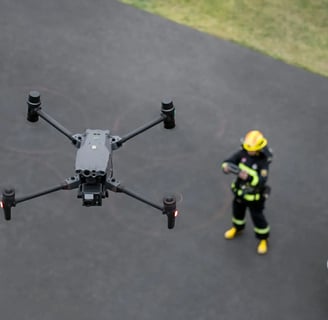Soaring Heroes: The Impact of Drones in Search and Rescue Operations
In the realm of emergency response and search and rescue (SAR) efforts, technology has become an invaluable ally. Among the most transformative tools in this domain are drones, unmanned aerial vehicles that are changing the dynamics of rescue operations.
12/29/20232 min read


This article explores the ways in which drones are becoming indispensable in search and rescue missions, showcasing their capacity to save lives and enhance the efficiency of emergency response teams.
1. Rapid Deployment and Accessibility:
Time is of the essence in search and rescue operations. Drones offer a rapid deployment advantage, quickly reaching areas that might be challenging for ground teams to access. Whether it's a dense forest, mountainous terrain, or disaster-stricken zones, drones can swiftly navigate these environments, providing eyes in the sky within minutes of deployment.
2. Aerial Surveillance and Situational Awareness:
Equipped with advanced cameras and sensors, drones provide real-time aerial surveillance, offering unprecedented situational awareness to rescue teams. This capability is crucial in identifying the location of missing persons, assessing the extent of disasters, and monitoring dynamic situations. The live footage transmitted by drones aids decision-makers in formulating effective strategies for rescue efforts.
3. Night Vision and Thermal Imaging:
Search and rescue operations don't adhere to a 9-to-5 schedule. Drones equipped with night vision and thermal imaging technologies extend operational capabilities beyond daylight hours. These features are invaluable in locating missing persons or survivors in low-light conditions or dense foliage, enhancing the effectiveness of search missions around the clock.
4. Communication Relay:
In areas with compromised communication infrastructure, drones serve as communication relays. They can be equipped with communication equipment to establish a temporary network, facilitating coordination between rescue teams. This becomes especially crucial in disaster-stricken areas where conventional communication channels may be disrupted.
5. Water Rescue Operations:
Drones are equally effective in water rescue operations. Equipped with flotation devices and waterproof cameras, drones can quickly survey large bodies of water, locate drowning victims, and guide rescue teams to the precise location. This capability is a game-changer in improving response times and increasing the chances of successful water rescues.
6. Search Pattern Optimization:
Drones can employ advanced algorithms to optimize search patterns. Through the integration of artificial intelligence, drones can analyze terrain, topography, and other relevant data to determine the most efficient search routes. This not only speeds up the search process but also maximizes the coverage area, increasing the likelihood of locating missing persons or disaster survivors.
7. Reduced Risk to Rescuers:
Search and rescue missions often involve risks for the rescue teams themselves. Drones mitigate these risks by minimizing the need for ground personnel to enter hazardous or inaccessible areas. This not only enhances the safety of the rescue operation but also allows human responders to focus on executing the rescue once the target has been identified.
Conclusion:
Drones are emerging as unsung heroes in search and rescue operations, rewriting the playbook for emergency response teams worldwide. Their ability to provide rapid deployment, aerial surveillance, night vision, communication relay, water rescue support, search pattern optimization, and risk reduction for ground teams makes them an indispensable asset in saving lives. As technology continues to advance, the partnership between drones and search and rescue efforts promises a safer and more efficient future for emergency response operations.
Aerogrit Sdn Bhd (1547412-H)
Level 3, Wisma Suria, Jalan Teknokrat 6, 63000 Cyberjaya, Malaysia
+60111 099 4567
hello@aerogrit.com
© Aerogrit Sdn Bhd | Cyberjaya, Malaysia
